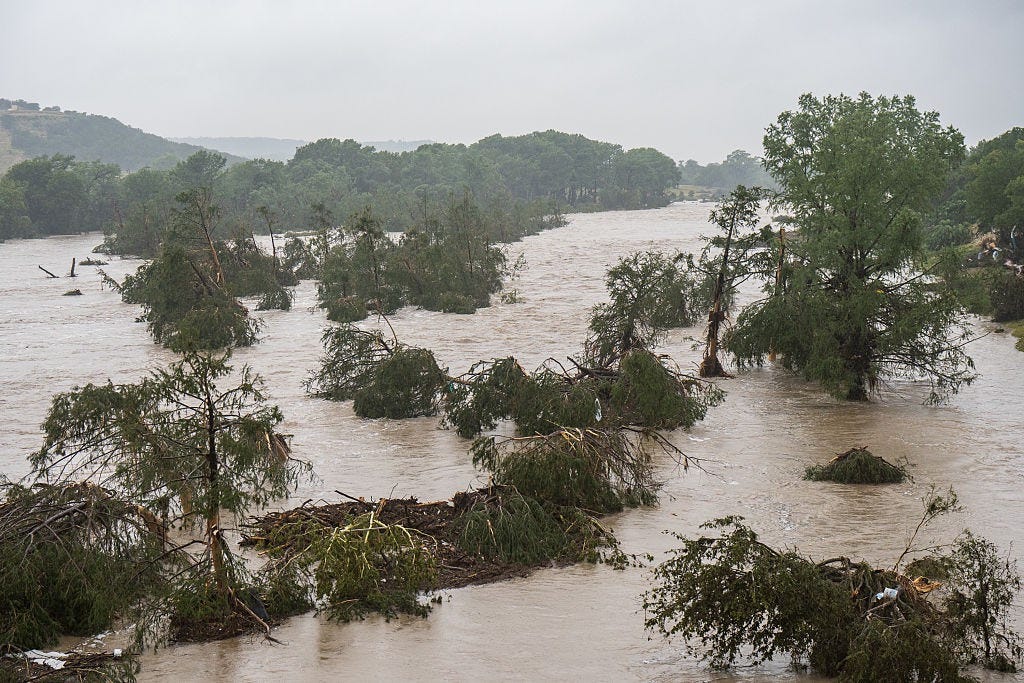|
 |
Without trustworthy, independent, free news media, democracy falls apart. Yet most news sources today are either controlled by billionaires, inundated with misleading ads, or have all their most important stories paywalled.
HEATED is keeping independent journalism accessible. We take no billionaire money, no ad money, and every article under one year old is free.
We need reader support to keep this model alive. Without ads or foundation money, reader donations are the only way we can fund this work. If you can afford it, and you value real independent climate journalism, consider becoming a paid subscriber today.
Abbott says megafloods are “just part of nature.” The fossil fuel industry disagrees.
In leaked audio from a meeting last month, gas industry representatives acknowledged that extreme weather is getting wackier and more dangerous.
This is a special joint edition of HEATED and ExxonKnews, a climate newsletter written by reporter Emily Sanders. ExxonKnews specializes in covering fossil fuel industry disinformation, dark money, and lobbying, as well as efforts to hold the industry accountable. ExxonKnews is a project of the Center for Climate Integrity. Sign up here.
Less than a month before deadly flash floods devastated Kerr County, Texas, representatives of the oil and gas industry gathered about 100 miles away to discuss how to protect themselves from increasingly frequent and damaging extreme storms.
At the Omni hotel along the San Antonio River, the American Gas Association — a trade association and lobbying group for the U.S. gas industry — organized a group of industry and utility representatives, as well as members of the National Governors Association, the Department of Energy, and the Federal Energy Regulatory Commission, to talk about how to prepare pipeline infrastructure and the energy grid “for high demand seasons and severe weather events,” according to a leaked agenda and audio from the event.
They heard from Matt Lanza, a meteorologist from Houston-based CenterPoint Energy, who discussed how warmer Gulf waters earlier in the season have caused more frequent, damaging hurricanes and tropical storms across the Gulf Coast and Southeast.
"When I started off in energy, summer was not sit-back-and-relax time from a weather standpoint, but you could kind of ease up a little bit," he said. "But like now you're just constantly on edge... if you look at the last 10 summers, I think all 10 of them are in the top 15 hottest from a cooling degree day standpoint."
While he predicted a slightly above-normal hurricane season for the Gulf Coast this year, he reminded the room: “It doesn't necessarily take a hurricane to cause issues, which I think we're all very keenly aware of.”
"It sounds to me more like we may have less extreme mega storms, but a lot more storm tantrums,” reflected Kimberly Denbow, vice president of security and operations at the American Gas Association. “Like a little tantrum that causes a big ruckus, which requires preparedness on all of our parts, because clearly there's consequences that come with those as well.”
Less than a month after that meeting, one of those “storm tantrums” hit Texas. It didn’t hit any oil and gas infrastructure, but it did hit a summer camp on the banks of the Guadalupe River, killing more than 100 people, at least 27 of them children or counselors.
How climate change intensified the floods
The severity of the flooding was both exceedingly rare and a convergence of very predictable circumstances: in a region called Flash Flood Alley, the combination of hills and nearly impermeable drought-parched soil made for an unstoppable deluge when more than a foot of rain fell fast.
It’s the type of climate-fueled disaster that’s becoming more frequent and severe all over the country due to fossil fuel pollution. As heat-trapping gases concentrate in the atmosphere, the Earth’s water cycle is intensified, leading to more severe torrential downpours when rainfall does occur. An analysis published Monday by research partnership ClimaMeter found that climate change intensified the rainfall that caused the flooding in Texas.
“We can see why it’s essential to decarbonize and electrify our economy,” wrote Andrew Dessler, a climate scientist at Texas A&M University, this week. “The role of climate change is like steroids for the weather… Every weather event we see now carries some influence from climate change. Measuring the exact size takes careful attribution studies, but basic physics already tells us the direction: climate change very likely made this event stronger.”
